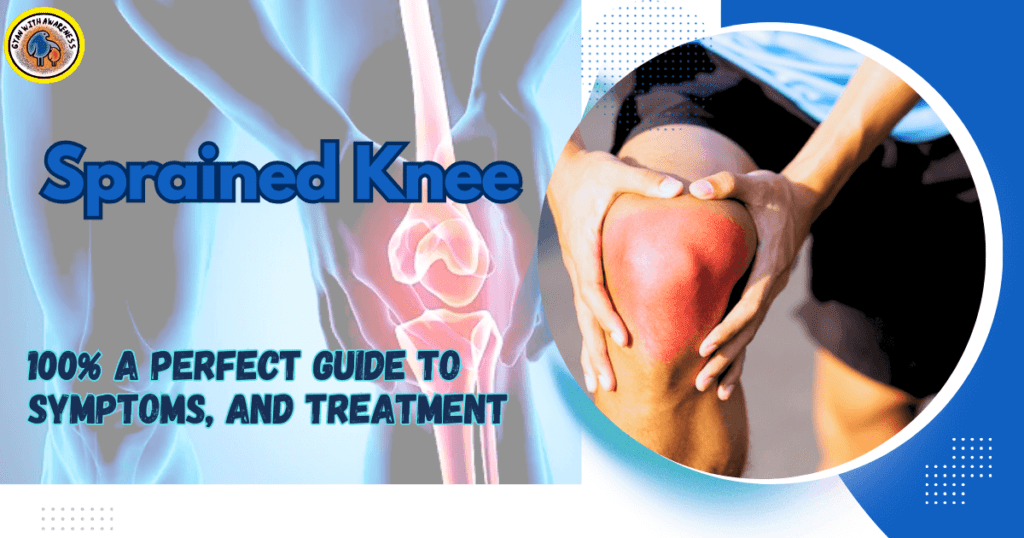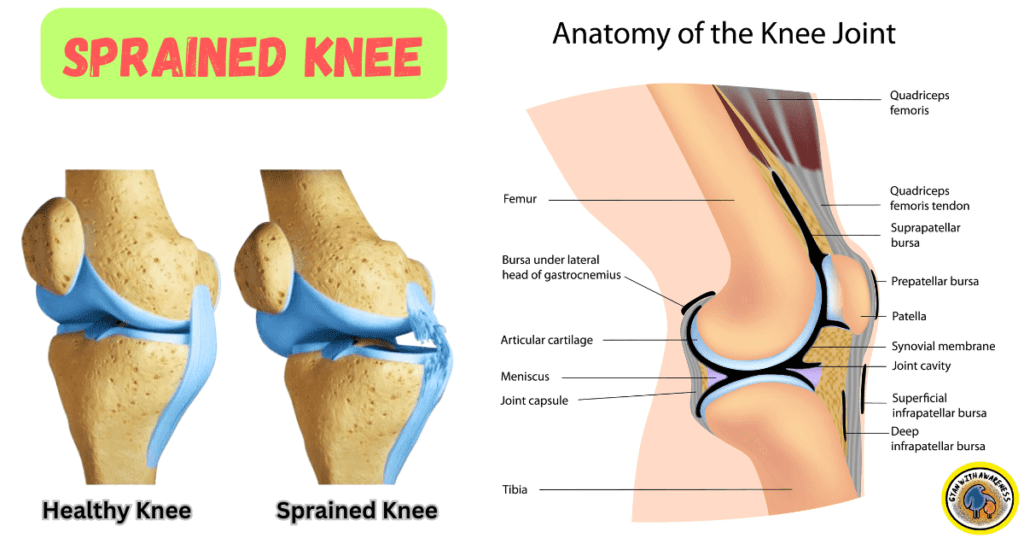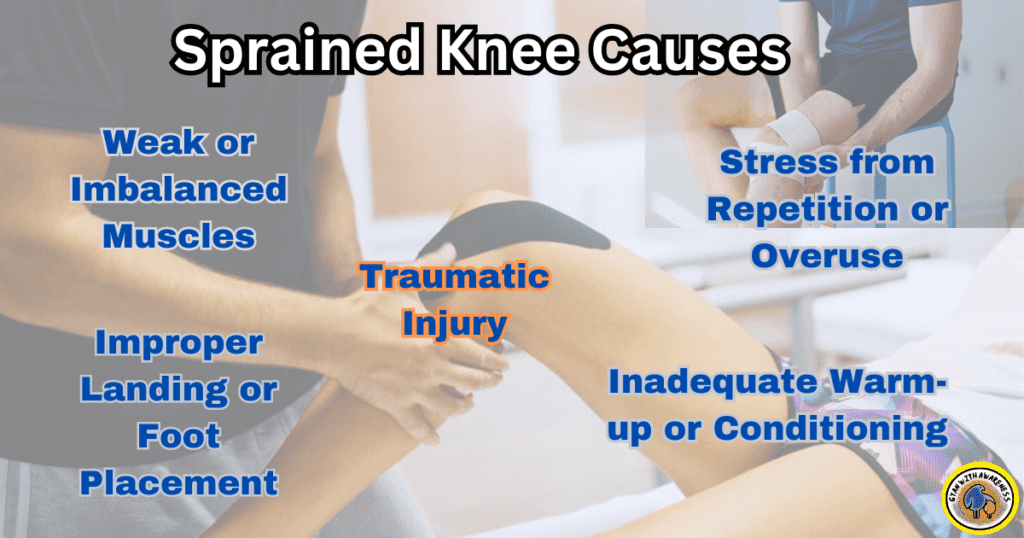Welcome to our in-depth guide on sprained knees. Whether you’ve recently experienced a knee injury or want to be prepared, this comprehensive article covers sprained knee symptoms, quick healing techniques, treatments, recovery timelines, and more. Let’s dive into the world of sprained knees and empower you with the knowledge to navigate this common injury.

Overview of sprained knees:
One typical orthopedic ailment that causes damage to the knee’s supporting ligaments is a sprained knee. Sudden twists, falls, or impacts can cause these ligaments, which are essential for stability and appropriate mobility, to become stretched or ruptured. Being a crucial joint in the human body, the knee can sprain mildly or severely, which can affect everyday activities and general mobility. Athletes frequently sustain this injury, especially those who play sports requiring quick direction changes or forceful physical contact. Outside of sports, sprained knees can happen in a variety of regular situations, highlighting how common this injury is. For efficient treatment and recovery, it’s critical to identify the symptoms and get medical help as soon as possible.
This introductory insight sets the stage for a deeper exploration into the causes, symptoms, and treatments associated with sprained knees, shedding light on the importance of proactive care and rehabilitation.

Also Read: Alleviating Knee Pain: 101% Best A Comprehensive Guide
Runners Knee Stretches: Keeping You 100% Strong and Pain-Free
Best 11 Foods for Pregnant Females: Nourishing Both Mom and Baby
The Benefits of Tofu: Best Diabetes-Friendly Food, Part 12
Sprained Knees and Their Type:
Grade 1 (Mild):
Ligaments are stretched but not torn.
Mild pain and swelling.
A full range of motion is usually maintained.
Grade 2 (Moderate):
Partial tearing of ligaments.
Moderate pain, swelling, and stiffness.
Some loss of function and increased instability.
Grade 3 (Severe):
Complete tear of ligaments.
Significant pain, swelling, and stiffness.
Substantial loss of function and increased joint instability.
Main Symptoms and Causes of Sprained Knee
Sprained Knee Symptoms:
Recognizing a sprained knee is crucial for prompt intervention.
Pain and Swelling: Experience discomfort and noticeable swelling around the knee area.
Limited Range of Motion: Difficulty moving the knee as freely as usual.
Bruising: Visible discoloration due to damaged blood vessels.
Sprained Knee Causes:
Traumatic Injury:
A sprained knee can result from abrupt, violent twisting or bending of the knee joint, which frequently happens during athletic activities.
One typical traumatic cause is a direct impact on the knee, such as from a fall or collision.
Stress from Repetition or Overuse:
Running and jumping are two activities that repeatedly strain the knee joint without providing enough time for healing, which can lead to overuse injuries like sprains.
Weak or Imbalanced Muscles:
Insufficient strength or imbalance in the muscles surrounding the knee may lead to instability, making the joint more susceptible to sprains, especially during sudden movements.
Improper Landing or Foot Placement:
Landing awkwardly after a jump or making sudden changes in direction with improper foot placement can put excessive strain on the knee ligaments, increasing the risk of sprains.
Inadequate Warm-up or Conditioning:
Failing to warm up adequately before engaging in physical activities can reduce the flexibility of muscles and ligaments, making the knee more prone to injuries, including sprains. Proper conditioning helps prepare the body for the demands of exercise.

The factor of Sprained Knee:
Ligament Tearing or Stretching:
The main cause of a sprained knee is usually abrupt, powerful motions that stretch or tear the ligaments connecting the bones within the knee joint.
Biomechanical Factors:
Individual differences in biomechanics, such as variations in joint alignment, muscle imbalances, or irregularities in gait, can contribute to an increased susceptibility to knee sprains.
Environmental Conditions:
Uneven surfaces, slippery terrain, or participation in sports with a high risk of sudden direction changes can create conditions that elevate the likelihood of sustaining a sprained knee.
Previous Injuries:
Individuals with a history of knee injuries, especially if not fully healed or rehabilitated, may have weakened structures, making them more prone to experiencing sprains.
Insufficient Protective Gear:
Engaging in activities without appropriate protective gear, such as knee braces or supportive footwear, can expose the knee joint to higher risks of injury, including sprains.
Healthcare Assessment and Diagnostic Measures
Healthcare Assessment:
Comprehensive Patient History:
Gathering detailed information about a patient’s medical history, including past illnesses, family history, and lifestyle factors, to assess overall health.
Physical Examination:
Conducting a thorough examination of the patient’s body, including vital signs, appearance, and organ systems, to identify signs of health or potential issues.
Functional Assessment:
Evaluating the patient’s ability to perform daily activities and assessing factors such as mobility, strength, and coordination.
Diagnostic Testing:
Utilizing various medical tests, such as blood tests, imaging studies, and other diagnostic tools, to obtain objective data about the patient’s health status.
Psychosocial Assessment:
Considering the patient’s mental and emotional well-being, including factors like stressors, social support, and mental health conditions, to provide a holistic view of their health.
Diagnostic Measures:
Laboratory Tests:
Conducting blood, urine, or other bodily fluid analyses to detect abnormalities, infections, or imbalances that may indicate specific health conditions.
Imaging Studies:
Using technologies like X-rays, CT scans, MRI, or ultrasound to visualize internal structures and identify abnormalities, injuries, or diseases.
Biopsy:
Collecting a tissue sample from a specific area of the body for microscopic examination, aiding in the diagnosis of diseases such as cancer.
Electrocardiogram (ECG or EKG):
Recording the electrical activity of the heart to assess cardiac function and identify irregularities or abnormalities.
Endoscopy:
Employing a flexible tube with a light and camera to visualize and examine the interior of organs or body cavities, assisting in the diagnosis of conditions affecting those areas.
How to Heal a Sprained Knee Quickly:
Proven Techniques for Speedy Recovery:
Discover effective methods to expedite the healing process.
Rest and Ice: Allow your knee to rest, applying ice intermittently to reduce swelling.
Compression and Elevation: Use compression bandages and keep the leg elevated to minimize inflammation.
Physical Therapy: Engage in targeted exercises to strengthen and stabilize the knee.
Sprained Knee Treatment:
Tailored Approaches for Recovery
Explore various treatments catering to different degrees of sprained knees.
Grade I Sprain: Mild sprains often heal with rest, ice, and over-the-counter pain relievers.
Grade II Sprain: Moderate sprains may require bracing or a splint to immobilize the knee.
Grade III Sprain: Severe sprains might necessitate surgery for complete recovery.
Comprehensive Approaches for Relief
Discover a range of treatments, ensuring you find the one that suits you.
RICE Protocol: Rest, Ice, Compression, and Elevation.
Medications: Pain relievers and anti-inflammatories aid in managing symptoms.
Therapeutic Exercises: Strengthening exercises enhance knee stability.
Sprained Knee Recovery Time:
Patience and Perseverance
Understand the expected timelines for a full recovery.
Mild Sprains: Typically heal within 2-4 weeks.
Moderate Sprains: Recovery may take 4-8 weeks with consistent treatment.
Severe Sprains: Full recovery may extend to several months.
How Long Does a Sprained Knee Take to Heal:
Individual Factors at Play
Explore the nuances that influence healing times.
Factors include:
Age: Younger individuals often recover faster.
Severity: The extent of the sprain impacts recovery duration.
Treatment Adherence: Following medical advice accelerates healing.
Sprained Knee Surgery:
Surgery for a knee sprain is typically uncommon, as most cases respond well to non-surgical treatments. However, in severe sprains with significant ligament damage, surgical intervention may be considered. Procedures often involve repairing or reconstructing torn ligaments, commonly the anterior cruciate ligament (ACL). Surgeons may use arthroscopy, a minimally invasive technique, to visualize and address the injury. Post-surgery, rehabilitation is crucial to restore strength and functionality. While surgical options exist, decisions are made on a case-by-case basis, with healthcare professionals assessing the severity of the sprain and the individual’s overall health and lifestyle factors.
TIPS:
Remain Vigilant:
Keep an eye out for potential dangers and your surroundings. To maintain your attention on your surroundings, keep distractions at bay.
Employ the Right Tools:
To lower the chance of harm, wear the proper safety clothing and equipment, such as gloves, helmets, or safety glasses, for the activity you’re doing.
Observe the Rules:
Respect safety policies and procedures whether you’re at work, playing sports, or having fun.
Take Breaks:
Avoid overexertion by taking regular breaks during prolonged activities. Rest helps prevent fatigue and reduces the chance of accidents.
Communicate Clearly:
Maintain clear communication, especially in group activities or work settings, to ensure everyone is aware of potential risks and can collaborate for a safer environment.
Secure Your Environment:
Keep your surroundings organized and free from clutter to minimize tripping hazards and create a safer space.
Remain Up to Date:
Remain aware of any possible risks or hazards associated with the things you do. To prevent accidents, awareness is essential.
Look for Instructions:
Make sure you have received the appropriate training for any activities that call for specialized knowledge or abilities so you can safely negotiate any hazards.
Maintain Hydration:
Keep yourself properly hydrated, especially when engaging in physical activity, to promote general health and avoid dehydration-related problems.
Embrace Your Gut Feelings:
Whenever anything feels uneasy or dangerous, follow your gut and take the appropriate safety measures. Being careful is preferable to running the chance of harm.

FAQ:
Can I Walk with a Sprained Knee?
Absolutely, but it’s crucial to use crutches initially to avoid additional strain.
Should I Apply Heat to a Sprained Knee?
No, heat can increase swelling. Stick to ice for the first 48 hours.
When Can I Resume Physical Activities?
Gradually reintroduce activities after consulting with a healthcare professional.
Does Severe Sprain Surgery Always Need to Be Done?
Not every time. In cases where conservative measures prove ineffective, surgery may be recommended.
Can I Avoid Getting Sprained Knees Again?
The risk can be decreased with protective clothing, appropriate warm-ups, and strengthening activities.
How Can I Pick the Best Knee Brace?
To determine which brace is best for your situation, speak with a healthcare provider.
How long does a sprained knee take to heal?
A sprained knee’s recovery period varies according to its severity. In most cases, mild sprains heal in 2-4 weeks with rest and conservative care. Bracing or splinting may be necessary for 4–8 weeks for moderate sprains. Severe sprains can take months to heal; in certain situations, surgery is required. Healing is influenced by individual characteristics such as age, treatment compliance, and the severity of the sprain. Always seek the opinion of a healthcare provider for particular guidance regarding the length of time and suitable recovery procedures for your situation.
What measures can be taken to avoid knee sprains?
To prevent knee sprains, adopt several key measures. First, focus on strengthening muscles around the knee through targeted exercises, enhancing joint stability. Ensure proper warm-up before physical activities to optimize flexibility. Invest in supportive footwear suitable for specific activities to reduce strain. Employ correct techniques during sports or exercise, emphasizing proper form to minimize the risk of injury. Lastly, maintain a healthy weight to alleviate excess stress on the knees. Consistently integrating these practices into your routine promotes knee health, reduces vulnerability to sprains, and supports overall joint well-being. Regular exercise and consultation with healthcare professionals contribute to a comprehensive prevention strategy.
Strengthening Exercises:
Engage in targeted exercises to strengthen the muscles around the knee, focusing on the quadriceps, hamstrings, and calf muscles for improved joint stability.
Proper Warm-Up:
Always perform a thorough warm-up before physical activities to enhance blood flow, increase flexibility, and prepare the muscles and ligaments for the stress of movement.
Appropriate Footwear:
Invest in well-fitted, supportive footwear designed for specific activities, providing proper cushioning and alignment to reduce the risk of knee sprains.
Technique Awareness:
Practice and maintain proper techniques during sports and exercise, emphasizing correct form to avoid putting unnecessary strain on the knee joints.
Weight Management:
Maintain a healthy weight to reduce the load on the knee joints, minimizing the risk of overuse injuries and decreasing susceptibility to knee sprains.
Under what circumstances should I seek consultation with my healthcare provider?
Under several conditions, such as severe or chronic symptoms that interfere with day-to-day functioning, abrupt and inexplicable changes in your health, or when over-the-counter medications don’t work, you should see your doctor. Seek medical assistance for wounds, chronic discomfort, or worrying changes in long-term problems. Annual physicals are essential for early detection of potential health problems and preventive care. Additionally, for advice on immunizations, screenings, and general wellness techniques, speak with your healthcare professional. To promote optimal health and proactively address medical concerns, open communication is essential for ensuring early action. Frequent visits help create a thorough, individualized healthcare plan that is suitable for your requirements.
What inquiries should I pose to my doctor?
Are there any specific tests, screenings, or preventive measures I should consider?
What is the expected prognosis, and what signs should I monitor for improvement or worsening of my condition?
Are there lifestyle changes or self-care measures that can help manage my condition?
What are the available treatment options, and what are their potential side effects?
What is the exact nature of my condition or symptoms?
How does a knee sprain differ from a ligament tear?
Although they both entail ligament damage, a ligament rupture and a knee sprain are not the same in severity. A sprain of the knee is the result of partially torn or stretched ligaments, which causes discomfort and swelling. There are three grades: mild (Grade 1), and severe (Grade 3). A ligament tear, on the other hand, suggests a more serious damage, frequently involving a total rupture of the ligament. Ligament rips frequently necessitate more thorough treatment, such as surgery, because they can seriously compromise joint stability and function. The main difference is the degree of ligament damage; a sprain indicates a less serious injury than a tear.
Under what circumstances should I seek immediate attention in the emergency room?
Severe Injuries:
Seek emergency care for significant injuries, such as fractures, dislocations, or injuries causing excessive bleeding, to ensure prompt evaluation and treatment.
Difficulty Breathing:
If experiencing sudden and severe difficulty breathing, chest pain, or symptoms of a heart attack, it is crucial to seek immediate attention in the emergency room.
Loss of Consciousness:
Unexplained loss of consciousness or prolonged unconsciousness requires urgent evaluation to determine the underlying cause and ensure appropriate medical intervention.
Severe Allergic Reactions:
Immediate medical attention is essential for severe allergic reactions, characterized by symptoms like difficulty breathing, swelling, or a rapid and pronounced onset of hives.
Suspected Stroke:
Symptoms such as sudden numbness or weakness on one side of the body, difficulty speaking, or severe headache may indicate a stroke and warrant immediate emergency room evaluation.
Also Read: The Benefits of Tofu: Best Diabetes-Friendly Food, Part 12
Diabetes Cure | Best Mediterranean Chickpea Salad | Part 11
Innovative Grilled Salmon Recipes | Diabetes Cure | Part 10
Diabetes Cure | Delicious Barley Vegetable Soup | Part 9
Delicious Gooseberry Chutney | Diabetes Cure | Part 8
Exquisite Lentil Salad | Diabetes Cure Recipes | Part 7
Best Diabetes Cure | Grilled Fish Recipes | Part 6
Best Diabetes Cure | Brazil Nuts Recipes | Part 5
Best Diabetes Cure | Greek Yogurt Smoothie Recipes | Part 4
Best Diabetes Cure | Greek Salad Recipe | Part 3
Powerful Diabetes Cure Recipes | Detox Island Green Smoothie | Part 2